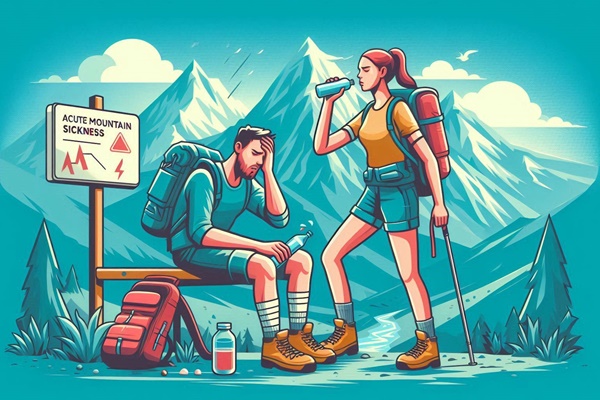Thousands of people visit the mountains every year. From regular tourists to the adventure enthusiasts engage in various types of activities starting from car sightseeing to trekking on the mountains or any mountaineering pursuit.
High Altitude, be just the figures or the environment around fascinates us all, isn’t it? At the same time if approached casually, the otherworldly heavenly heights of the mountains can prove to be a serious matter.
Have you come across the term AMS, or high-altitude sickness, yet? If not, then this is the right time to get yourself informed on this typical medical condition that you may face on your next tour in the mountains.
One assumption here is that we consider going to an altitude of at least 3000 m/10000 ft. or above and possibly sleeping a night at that altitude or above.
Worry not, with proper understanding one can easily avoid it. Here in this article, I will try to guide you through this hazard in a precise and concise manner so that you can plan and prepare for your next high-altitude trip accordingly safely.
What is AMS?
Acute Mountain Sickness, also known as High Altitude Sickness (HAS), occurs when you gain altitude faster than your body can cope with. Clinical manifestations range from headache, nausea, sleep disturbance, dizziness and confusion to more severe life threatening conditions such as fluid building up in your lungs or brain.
No need to be too concerned though. Understanding the risk and taking necessary precautions, it can be prevented or effectively managed.
Causes of Acute Mountain Sickness
As the altitude increases, the atmospheric pressure decreases. As a result, with increased altitude air gets thinner and thinner. The concentration of oxygen molecules in a certain volume of air gets diluted. Hence you inhale less amount of oxygen molecules with each gulp of breath in higher altitude in comparison to the plains. This forces your cardiovascular system to work harder to deliver adequate oxygenation each and every cell of your body including your vital organs.
In the following chart you’ll find how the effective oxygen percentage changes with increasing altitude.
You’ll see that at average mean sea level it’s approx. 21%. Beyond 3000 m it dips down to below 15% and beyond 5000 m it’s almost half of what you get at sea level.
When you climb too rapidly this system fails to keep up and an imbalance between oxygen supply and demand occurs. That imbalance leads to an array of unpleasant symptoms triggering a cascade of physiological effects.
Symptoms of Acute Mountain Sickness
The symptoms of acute mountain sickness varies from person to person and may occur simultaneously or you may experience any single one. Sometimes symptoms of dehydration or food poisoning overlaps with the symptoms of AMS. Let me list the common symptoms of AMS first. Then I’ll tell you how to differentiate the symptoms of AMS from the rest. The common symptoms of AMS are as follows:
- Severe headache
- Disorientation
- Dizziness or drowsiness
- Loss of reasoning
- Insomnia
- Prolonged breathlessness
- Heaviness on chest
- Consistent fatigue.
- Wheezing
- Feeling nauseous
- Loss of appetite
- Loose Motion
Now to be sure if these symptoms are caused by AMS, you need to check your resting blood oxygen saturation level with a pulse oximeter. These devices are readily available online and offline in pharmacies.
If your blood oxygen saturation level is more than 10 points lower than the mean value of others in the group, your symptoms are caused by AMS.
Potential Complications
If we ignore the above mentioned symptoms and push ahead to higher camps, high chances are that your condition will worsen. Below we’ll see what happens in case of severe altitude sickness.
- HAPE
If fluid builds up in your lungs, it’s called HAPE ( High Altitude Pulmonary Edema). This makes breathing difficult. Dry, consistent cough and heaviness on chest is its most common symptom.
- HACE
In case of fluid build-up in brain, it’s called HACE (High Altitude Cerebral Edema). That leads to the swelling of brain. It causes severe headache, ataxia (or loss of coordination in laymen’s language), slurred speech etc. Eventually it leads to seizures and/or loss of consciousness.
Treatment
Once you notice and be sure that you’re hit by AMS, DESCEND IMMEADIATELY.
There’s no known cure of AMS as of yet. Yes, drugs like Acetazolamide (Popularly known by its brand name Diamox), Nifedipine and Dexamethasone can give you temporary relief and cause any kind of fluid build up to slow down but it is to be used only during evacuation.
Also there’s a portable hyperbaric bag called Gamow bag, named after its inventor, which can mimic the partial oxygen pressure of the mean sea level, but one can sustain in it for a few hours and the condition of the patient starts deteriorating right after s/he gets out. If you can still walk, the practical most solution is to lose altitude as soon as possible.
If you’re not in walking condition, you need to be evacuated with the help of a stretcher made out of ropes or a portable stretcher, if available.
If detected timely, you can avoid all these complications. Usually the condition of the patient improves as soon as s/he gets to below 9000 ft.
Now as we all know prevention is better than cure. That statement is so true to avoid AMS. Next we’ll look into just that.
Preventive Strategies:
There are a few precautionary measures you can take to keep AMS at bay. If you’ve come this far, read this part of the article most carefully.
As it goes. “prevention is better than the cure applies strongly here in case of
Hydrate, Hydrate and Hydrate. Keep drinking water. Drink at least 50% more than your usual water intake. Be it in the form of tea, coffee, soup or simply water; hydrate yourself as much as possible. Sometimes in treks or in mountaineering expeditions it’s not possible to hydrate properly while hiking or climbing due to lack of water source. Replenish that after you reach the camp.
Do not doze off right after you reach a higher camp. Sometimes you’re dead tired after reaching the campsite. You just feel like lying down and close your eyes for a few minutes. DO NOT DO THAT. If you close your eyes inside the tent when you’re that exhausted, you’re not going to wake up anytime soon. Change your wet, dirty clothes especially your damp socks and try to spend as much time as possible outside with your ears open and head covered. Go to bed (or sleeping bag) after and only after you’ve had something.
Walk high sleep low. Before you settle down in the higher camp, it’s best if you can climb a little higher, spend some time there and then descend to the camp for the night. It’s one of the most effective practices to acclimatise properly.
Climb slow. Above 10,000 ft (~3000 m), try not gain more than 1000 ft (~300 m) in a day if your schedule permits. If not, then you must spend at least 3 nights on some altitude before going above 11500 ft/3500 m, i.e. when you are about to cross the “tree-line”.
At times due to lack of availability of a campsite, if you need to camp at an altitude more than 3000 ft ( ~915 m) higher than the previous camp, take a rest day there to acclimatise properly.
Medication. There is one diuretic drug called Acetazolamide (or Diamox), which has gained popularity in the trekking and mountaineering circle as a preventive measure for AMS. This meta-analysis (https://www.amjmedsci.com/article/S0002-9629(21)00060-4/abstract) concludes the same. However, consult your doctor before taking it.
If you have prior acclimatisation issues at higher altitudes, for reasons unknown, you’ll be more susceptible to AMS during your next venture at high altitude. If you are one such individual, be mindful of the symptoms and follow these preventive strategies minutely.
Indications for Emergent Medical Intervention
We have briefly touched this point before in this article. Now we’ll delve a little deeper into this.
It’s a no brainer that in case one loses consciousness, s/he needs to be evacuated immediately to a lower altitude place, where oxygen is thicker.
Apart from that if one is hit by HAPE and is still conscious, s/he can be treated with Acetazolamide and/or Nifedipine depending on the severity of the fluid build-up.
HACE is more difficult to treat as it progresses rapidly. Along with Acetazolamide, Dexamethosone can be used to stabilise the patient. Do note though that Dexamethosone is quite a strong drug and it is a corticosteroid. Only trained individuals who are aware of the proper dosage should treat patients with this medicine.
However, as mentioned before, none of these medicines are cure for AMS. You need to loose altitude once you’re sure that you’re hit by AMS. Getting to more about it in the next point.
An Emphasis on Evacuation
Medical interventions can only do so much. Once your body shows the symptoms of AMS lose altitude as soon as possible.
As the mighty Sherpas keep saying “Don’t be a Gama in the land of Lamas.”
But the evacuation process is easier said than done. If the patient is disoriented, at least one strong member of the team or support staff needs to accompany the patient.
Things get even more complicated, if the patient is unconscious. Depending on the type of the terrain and the weight of the patient, a minimum of 4 or more strong members of the team or the adequate support staff need to carry the patient down.
That’s why you should always be aware of the staff to trekkers/climbers ratio if you’re not going alpine and booking your trek/expedition through an agency. Being over conscious about the budget may prove to be quite costly when an emergency arises. Better safe than sorry.
True that conquering new heights and taking in those breath taking views can be temping but one shouldn’t ignore the threat of AMS. Hopefully this article has equipped you with proper knowledge to handle the threat wisely. Now that you understand the symptoms and the risk, you’ll know when to turn back and start descending. Also you know what preventive measures you should take to minimalise the risk and complete your high altitude trek/expedition successfully.
I’ll end this article on that note. Happy planning. 🙂








Comments